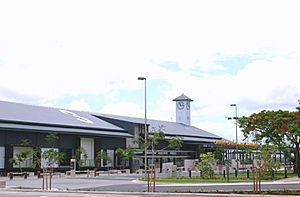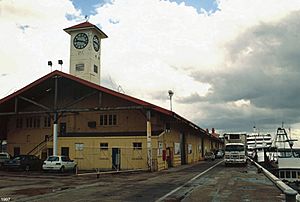Cairns Wharf Complex facts for kids
Quick facts for kids Cairns Wharf Complex |
|
|---|---|

Cairns Wharf Complex, 2010
|
|
| Location | Wharf Street, Cairns, Cairns Region, Queensland, Australia |
| Design period | 1900 - 1914 (early 20th century) |
| Built | 1910 - 1948 |
| Official name: Cairns Wharf Complex | |
| Type | state heritage (built) |
| Designated | 17 December 1999 |
| Reference no. | 601790 |
| Significant period | 1910-1964 (historical) |
| Significant components | wharf/dock/quay, views to, platform, views from, tower - clock, shed/s, loading bay/dock, railway, shed - storage, machinery/plant/equipment - transport - water |
| Lua error in Module:Location_map at line 420: attempt to index field 'wikibase' (a nil value). | |
The Cairns Wharf Complex is a special place in Cairns, Queensland, Australia. It's a group of old wharves and buildings along Wharf Street that are protected because of their history. This means they are "heritage-listed" on the Queensland Heritage Register. The complex was built between 1910 and 1948 and shows how important Cairns was as a port.
Contents
Discovering the History of Cairns Wharves
How Cairns Became a Busy Port
Cairns started as a port in the late 1800s. European settlers arrived at Trinity Inlet in 1876. Soon after, the area was officially made a port. This happened because of the new Hodgkinson goldfields nearby. Miners needed a way to get their gold out and supplies in.
At first, the port had simple wooden jetties. These were like long piers built over the mud and mangroves. They helped boats reach deeper water. Over time, private companies built better facilities. Shops, hotels, and government offices grew up around the port area.
The Railway Boosts Cairns' Success
In 1884, Cairns was chosen as the end point for a new railway line. This line would go to the Herberton tin fields. Building the Tablelands rail line helped Cairns a lot. It made Cairns the main port in the north. Other nearby ports like Cooktown and Port Douglas became less important.
Building Stronger Concrete Wharves
In 1906, the Cairns Harbour Board was created. Their job was to improve the port. They bought all the private wharves by 1915. They also started dredging the channel. This made it possible for bigger ships to enter the port after 1912.
The Harbour Board decided to build new, strong wharves. They used a new material called reinforced concrete. This was a big deal because Cairns was the first port in Queensland to use so much concrete for wharves. Construction started in 1910. By 1915, there was a long, unbroken line of concrete wharves. More extensions were added in the 1920s. A railway line was also built along the front of the wharves.
Handling Sugar and Other Goods
Cairns was one of the first ports in Queensland to use machines for handling sugar. This started in the mid-1920s. A large storage shed was built for sugar. It could hold thousands of tonnes of sugar. This shed later became known as "White's Shed".
Other sheds were built on the main wharves. These sheds stored goods that were waiting to be shipped out or brought into town. Electric and hand-powered cranes helped lift heavy items onto ships.
The Wharves During World War II
During World War II, Cairns was very busy. The wharves were extended again in 1943. A new shed, number 6, was also built. A building for the Waterside Workers was constructed in the 1940s. This building had lunch rooms, meeting spaces, and showers for the workers.
The Famous Clock Tower
A clock tower was added to shed number 3 in 1948. It was a very welcome addition for everyone working at the port. The clock was made in Sydney and cost a lot of money back then. It was featured on the front page of the local newspaper. The clock still chimes today and is a well-known landmark.
What Happened Next?
Over the years, many people worked at the Cairns wharves. Most of the busy shipping activity has now moved upstream. Newer wharves were built in the 1960s for things like bulk sugar. The older wharves are mostly used for recreational boats and passenger ships today.
In 2010, a project started to update the wharves. Shed number 3 was turned into the new Cairns Cruise Liner Terminal.
Key Structures of the Cairns Wharf Complex
The Cairns Wharf Complex includes several important parts. These are concrete wharves 2 and 3, their sheds and the clock tower, White's (sugar) shed, an electrical shop, an amenities hall, a cargo crane, concrete roads, railway tracks, and gate number 2 with its flagpole and planters.
Concrete Wharves: Strong and Busy
The concrete wharves are still used today. They are made of strong reinforced concrete. The edges have wooden beams. Power points and water taps are placed along the wharf for ships. Mooring irons are used to tie boats securely.
Wharf Sheds 2 and 3 and the Clock Tower
Wharf sheds 2 and 3 are long, rectangular buildings. They have corrugated metal walls and roofs. These buildings are in good condition, especially considering how old they are and how much they've been used.
The loading docks behind the sheds are still mostly there. They are made of timber and concrete. These docks helped load and unload goods from railway cars.
The clock tower sits on top of shed number 3. It has a clock face on all four sides. The tower has a pointed roof and a weather vane. The clock still works well and chimes every hour.
Today, shed number 2 is the Cairns cruise ship terminal. Shed number 3 is used for storage by the Port Authority and other shipping companies. It also has offices for the Customs Service.
The Cargo Crane: A Piece of History
A cargo crane is located at the end of the loading dock behind shed number 2. This crane is very old and was used to lift heavy goods. It's the last remaining crane from the early days of the wharf.
White's Sugar Shed: A Sweet History
White's Shed is a large building made of timber and iron. It's located behind wharf number 4. This shed was built in 1923 to store sugar. It had a special conveyor system to move sugar bags. This system helped load sugar onto ships and railway wagons.
The shed's structure is mostly intact. You can still see parts of the sugar bag stacking machinery inside. However, the conveyors that extended outside the shed are gone.
The shed was no longer used for sugar after 1964. This was because a new bulk sugar terminal opened. The new terminal could store huge amounts of sugar without needing bags. This changed how sugar was handled and reduced the number of workers needed. White's Shed was later used by mining companies for storage.
The Electrical Workshop
The Electrical Workshop is a brick building located near White's Shed. It used to supply power to the wharves. It also served as a workshop for electrical repairs. Today, it's used as the Cairns Port Authority's Social Club.
The Amenities Hall
The Amenities Hall is a timber building located next to the Electrical Shop. It was built in 1954 for the Waterside Workers' Federation. It had rooms for lunch, meetings, and toilets. Since 1988, it has housed collections from the Maritime Archaeological Association.
Gate Number 2: An Old Entrance
The ornamental gateposts at gate number 2 are still in their original spot. This gateway has an entrance and exit lane. It shows how people used to enter and leave the wharf complex. The original gates are no longer there.
Railway Tracks: Connecting the Port
Several railway tracks were laid at the Cairns wharves. Parts of two sets of tracks are still visible. These tracks were very important. They connected the port to the railway lines that went inland. This helped Cairns become a successful port and a thriving town.
Why the Cairns Wharf Complex is Important
The Cairns Wharf Complex is listed on the Queensland Heritage Register because it's very important to Queensland's history and culture.
- Shows How History Evolved: It shows how wharf facilities developed in Australia from 1909 to 1942. The use of reinforced concrete was a big step forward. The wharves also show Cairns' importance during World War II. The old cargo sheds and the cargo crane give us a glimpse into the port's industrial past. White's Sugar Shed shows how the sugar industry changed. The railway lines highlight how important trains were for Cairns' success as a port.
- Rare and Special: The wharf sheds and White's Sugar Shed are rare. Many old wharf sheds in Australia have been removed. White's Shed, with its old sugar bag-stacking machines, is unique in Queensland and Australia.
- Helps Us Learn: The old machinery in White's Shed can teach us a lot about how sugar was handled in the past. Records of this system have been lost, so studying the physical features helps us understand it better.
- Shows What a Wharf Is Like: Sheds 2 and 3 are great examples of how cargo handling buildings at a wharf were designed.
- Looks Great: The wharves, gate number 2, White's Shed, and sheds 2 and 3 (with the clock tower) make Cairns look special. They frame the views down the city streets towards Trinity Inlet. The clock tower is a well-known landmark in Cairns.
- Shows Clever Design: The concrete wharves show how clever engineers were in the early 1900s. Using reinforced concrete for wharves was a big technical achievement.
- Important to the Community: The Cairns wharves, sheds, gate, and clock tower are very important to the people of Cairns. They are physical reminders of the city's history and identity. The clock tower has been the city's timepiece since 1948.
- Connected to Key Groups: The complex is strongly linked to the early Cairns Harbour Board. The wharves and sheds remind us how important the Board was in making Cairns a major port and helping the region grow.
Images for kids



